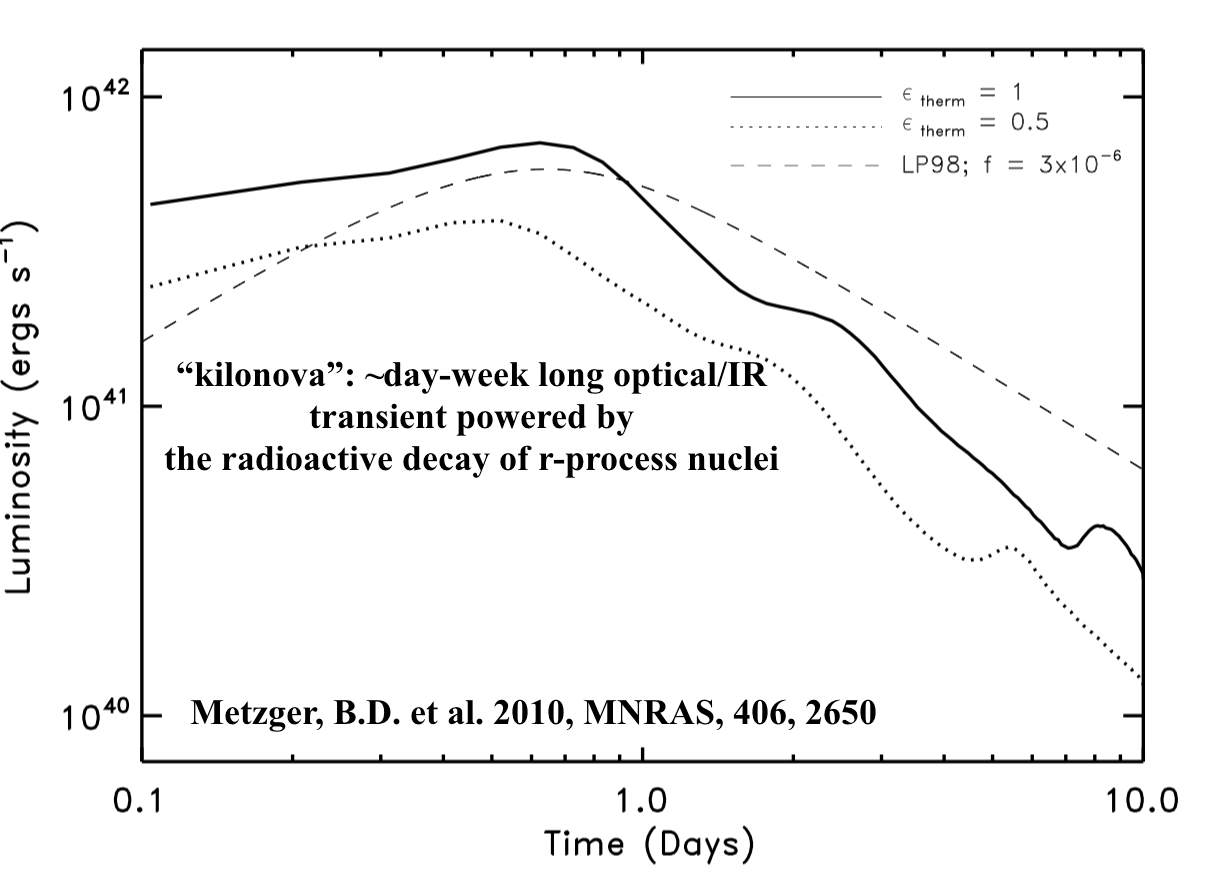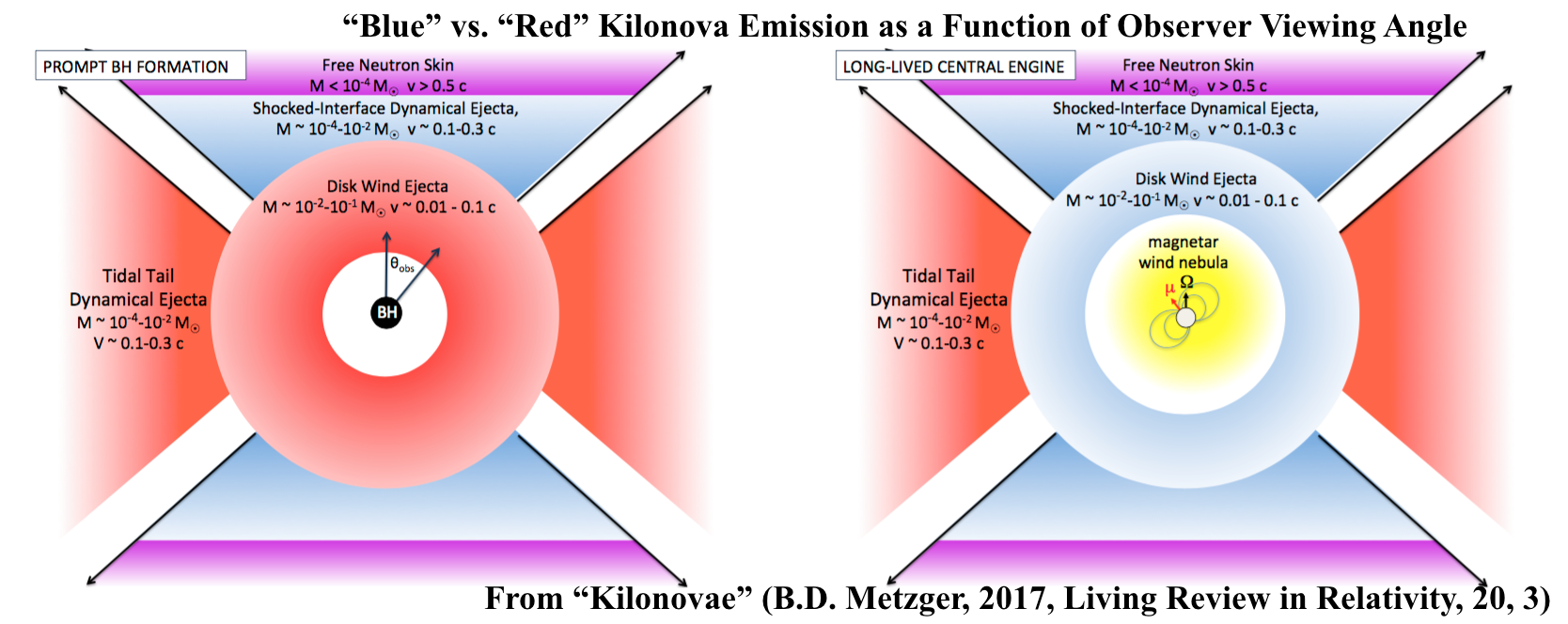
Brian Metzger
Department of Physics
909 Pupin Hall
New York, NY 10027, USA
Phone:212-854-9702

Brian Metzger
Phone:212-854-9702
I am a Professor in the Department of Physics at Columbia University and a member of the Theoretical High-Energy Astrophysics (THEA) group. I am also currently a Senior Research Scientist within the Center for Computational Astrophysics at the Flatiron Institute.
My Ph.D. was completed in the Departments of Physics and Astronomy at UC Berkeley under the supervision of Professor Eliot Quataert.
Click here for my CV and publication list.
I am interested in a broad range of topics in theoretical astrophysics, focused on high energy and stellar astrophysics. A unifying theme of my research is a connection to transient (or 'time domain') phenomenon, motivated by many sensitive, wide-field telescopes coming online in the next decade across the electromagnetic spectrum. I am excited by the scientific potential of the upcoming generation of gravitational wave interferometers, such as Advanced LIGO, and the promise for the impending era of "gravitational wave astronomy".


One area of my group's focus are theoretical predictions for the electromagnetic counterparts of binary neutron star mergers. Among the most promising counterparts is a day to week-long thermal optical/infrared counterpart, powered by the radioactive decay of heavy elements synthesized in the merger ejecta. In 2010, our group made the first predictions for this so-called "kilonova" emission, which included a realistic treatment of the relevant nuclear heating. To the left, I show an example predicted light curve (luminosity as a function of time since the merger) from 1% of a solar mass of r-process elements ejected from the merger at 10% the speed of light. The discovery of kilonova emission following a binary neutron star merger would provide the first direct evidence for the production of rare elements such as Gold, Platinum, and Uranium.
I recently completed a review on Kilonovae for Living Reviews in Relativity, which describes (among other things) the possible diverse signatures we may see from these events depending on the properties of the merging binary and the viewer's inclination angle with respect to the binary axis. Observers in the binary plane of the merger may observe mostly "red" (infared) emission from matter ejected in the binary plane, while observers from higher inclinations first observe relatively "blue" (optical) emission, similar to our 2010 predictions, from matter driven in the polar direction
2008: Calculation of the long-term (viscous timescale) evolution of the remnant accretion disks of neutron star mergers showing neutron-rich freeze-out and late-time outflows capable of r-process nucleosynthesis (with Tony Piro and Eliot Quataert).
2008: Model explaining X-ray emission following short gamma-ray bursts from magnetic spin-down of a long-lived magnetar remnant (with Todd Thompson and Eliot Quataert).
2010: Light curve calculation of r-process-powered optical counterparts of neutron star mergers which included for the first time self-consistent nuclear heating and radiative transfer; coined the term ``kilonova'' (with Gabriel Martinez-Pinedo, Siva Darbha, Eliot Quataert, and others).
2011: Prediction for the radio emission from jetted tidal disruption events, confirmed by the discovery just a couple months later of Swift J1644+57, the first jetted TDE (with Dimitrios Giannios).
2011: End-to-end calculation of GRB emission from the relativistic winds of strongly-magnetized newly-born magnetars. (with Dimitrios Giannios, Todd Thompson, and others)
2012: Predictions for nucleosynthesis, disk outflows, and fast-evolving optical transients from the merger of white dwarfs with neutron stars or black holes.
2012: Demonstrated the practical promise of kilonova as the most promising electromagnetic counterparts for the majority of binary neutron star mergers (with Edo Berger).
2013: First 2D hydrodynamical simulations of neutron star merger accretion disks demonstrating freeze-out and ejection of neutron-rich r-process material (with Rodrigo Fernandez).
2014: Prediction (later confirmed) that a large fraction of the optical luminosities of classical novae are powered by internal shocks rather than direct radiation from the white dwarf (with Indrek Vurm, Jeno Sokolowski, Laura Chomiuk, and others).
2014: Demonstrated how the lifetime of a hypermassive neutron star remnant can be encoded in the kilonova colors, with both ``blue'' and ``red'' kilonovae accompanying the same event, later confirmed in GW170817 (with Rodrigo Fernandez).
2015: Proposed an hours-long UV ``precursor" emission to kilonova emission from binary neutron star mergers powered by free neutron decay in the outermost layers of the ejecta. (with Andi Bauswein and others)
2017: Proposed AGN accretion disks as sites of LIGO binary black hole mergers (with Nick Stone and Zoltan Haiman, proposed simultaneous with Bartos et al. 2017).
2017: Proposed extremely strong-field magnetars, formed in superluminous supernovae or long GRBs, as sources of repeating fast radio bursts with associated persistent radio nebula. (with Edo Berger and Ben Margalit)
2017: First 3D MHD simulations of neutron star merger disks which demonstrate ejection of neutron-rich r-process material. (with Daniel Siegel)
2017: Using joint EM/GW inferences from LIGO's first neutron star merger GW170817, placed a constraint on the maximum mass of neutron stars. (with Ben Margalit)2019: Demonstrated that collapsar disk winds are promising sources of r-process nucleosynthesis which naturally explain r-process enrichment events in dwarf galaxies and proposed observational predictions of the scenario in LGRB SNe. (with Daniel Siegel and Jennifer Barnes)
My list of publications can be found on astro-ph or the Astrophysics Data System (ADS).
My Ph.D. thesis, titled "Theoretical Models of Gamma-Ray Burst Central Engines," can be found here. My dissertation was awarded the Dissertation Prize by the High Energy Astrophysics Division (HEAD) of the American Astronomical Society. In 2014, I was awarded an Alfred P. Sloan Research Fellow. I was named the 2020 Blavatnik National Laureate in the Physical Sciences and Engineering.Graduate & Undergraduate: I am happy to talk with interested students.
Previous Undergraduate Students: Justin Ripley (CU'14, Princeton PhD, now Cambridge), Aaron Kennon (CU'17, now Santa Barbara), Charles Zivancev, Miguel Martinez (CU'19, now Northwestern), Maggie Smith
Previous Graduate Students: Konstantin Bochkarev (Princeton), Siva Darbha (Berkeley), Andrey Vlasov, Aleksey Generozov (Technion), Ben Margalit (Berkeley), Andrea Derdzinski (Zurich)
Current Graduate Students: Dhruv Desai, Chengcheng Xin, Navin Sridhar, Semih Tuna
Former Postdoctoral Researchers: Nicholas Stone (Einstein Fellow, now Assistant Professor @ HUJI), Daniel Siegel (Einstein Fellow, now Assistant Professor at Perimeter/Guelph), Jennifer Barnes (Einstein Fellow, now KITP Fellow), Elad Steinberg (now Researcher @ HUJI), Eric Coughlin (Einstien Fellow, now Assistant Professor at Syracuse)
Current Postdoctoral Researchers: Mathieu Renzo (joint with CCA/Flatiron), Tatsuya Matsumoto (JSPS Fellowship)